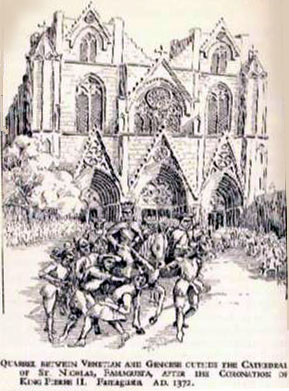|
|
 |
| The Reign
of Pierre II |
| Introduction |
Shortly after the accession of Pierre II occurred the fatal rupture between the Venetians
and the Genoese which heralded the fall of the Lusignan dynasty in Cyprus.
At Famagusta
in
1372 King Pierre II was crowned King of Jerusalem according to custom in the
cathedral of
St. Nicholas. As the procession was returning from the cathedral, a dispute arose between
the representatives of the two republics on a question of precedence.
At the banquet
after the ceremony the dispute broke out again and resulted in a fight in which several of
the Genoese were killed. |
| |
| Rupture
between Venetians and Genoese |
 |
| Genoese
and Venetians fighting after the coronation of King Pierre II at the St. Nicholas
Cathedral, Famagusta. |
Genoa
was not slow in taking her revenge. The Genoese fleet under Admiral Pietro di Campo
Fregoso landed troops in Cyprus. Nicosia and Famagusta were taken, the boy king was made a
prisoner, a crushing indemnity was imposed on the island and Famagusta was retained as
security for payment.
The position was complicated
by the quarrel between the queen mother, Eleanor of Aragon, and the guardians of the young
king, Jean, prince of Antioch, and Jacques, constable of Cyprus, who had both been
concerned in the assassination of King Pierre I. Queen Eleanor at first welcomed the
invaders as a means of avenging the murder of her husband, but when she saw that the
Genoese were bent on destroying her son's kingdom, she joined the other royalists and took
refuge with Jacques, the constable of Cyprus, in the Kyrenia castle.
The Genoese, determined to crush all opposition, sent a
force against Kyrenia and pitched their camp at Dhikomo. They were unable to force the
pass, which was held by the royalists, until a guide showed them and unguarded footpath
over the mountains by which they were able, like Persians at Thermopylae, to attack the
defenders in the rear and so to force a passage.
|
| |
| Siege
of Kyrenia and Loss of Famagusta |
In the spring of 1374 the castle was besieged and for several months resisted all attacks.
Unable to scale the walls, the Genoese brought up a great mangonel, or catapult, which
hurled immense stones against the walls, bringing the battered masonry down into the
ditch. But the defenders, under the able leadership of Jacques, repaired the walls and
repulsed the attacks on the breaches. An attempt was then made by sea.
A Genoese galley
forced against the chain across the harbour entrance succeeded in breaking through, but it
was driven back by missiles from the walls and the chain was replaced in position.
Although the siege was the most determined in the history of the castle, Kyrenia remained
impregnable, and continued to be the stronghold of the Lusignans during the Genoese
occupation of the island. Finally, in 1374, a treaty was concluded between the Genoese and
the government of Cyprus. The king was restored to his throne, Jacques, the constable, was
taken as a hostage to Genoa, where he remained until he succeeded to the throne, and
Famagusta was occupied by the Genoese until the indemnity should be paid.
The great city and port of Famagusta, which Sir John Mandeville thought the finest in the
world, was thus lost to the kings of Cyprus, for it was ceded altogether to the Genoese in
return for the release of Jacques when he came to the throne. Adalia, which had been
captured from the Turks by King Pierre I, was also claimed by the Genoese, but rather than
let it fall into their hands the king, with the advice of the High Court, ceded the town
to Tacca, the Turkish sultan, its former owner.
King Pierre II, after the loss of
Famagusta, built the first walls round Nicosia, four miles in circuit, which remained
until their destruction by the Venetians in 1564. The king died in 1382 and was succeeded
by his uncle, who was crowned in 1385 as King Jacques I of Cyprus and Jerusalem. |
| |
|
|
| References:
|
- From:
Newman, P., (1940), "A Short History of Cyprus",
Longmans, Green & Co., London.
|
|
Chronological
History |
|
 |
|









